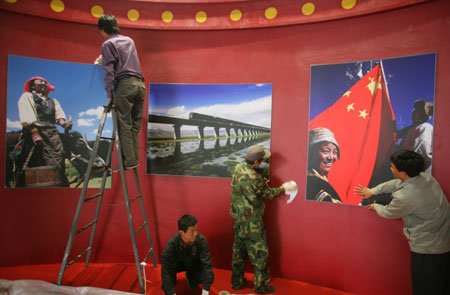Monastery reopens to worshippers
(China Daily)
Updated: 2008-04-30 07:10
Updated: 2008-04-30 07:10
LHASA: The Sera Monastery, one of the three key monasteries in Tibet, reopened to both worshippers and tourists on Monday.
 Workers arrange pictures in the Culture Palace of the Nationalities in Beijing April 30 for an exhibition on the history and development of Tibet, which opens Tuesday. [China Daily] |
It had been closed since the March 14 unrest in the regional capital.
"I'm very happy to see the monastery open again," Tibetan monk Gyaltsen Monlam said while turning prayer wheels at the monastery.
Buddhist services at the monastery resumed on April 20.
Tenzin Namgyal, deputy director of the Tibet autonomous regional ethnic and religious affairs committee, said: "In recent days, the monks have been taught legal knowledge and the monastery has resumed its normal religious activities.
"It's the first monastery in Lhasa to reopen to outsiders. The others will follow suit in the future.
"Many tourists and worshippers came to the monastery today, and many more are expected in the coming days," he said.
Zhang Jian, a tourist from Guangzhou, said: "I have been in Lhasa for two days. Life here is back to normal.
"But it is a shame the rain disturbed a scheduled Buddhist doctrine debate in the monastery on Monday."
The Sera Monastery sits at the foot of Tatipu Hill in northern Lhasa and is dedicated to the Gelugpa (Yellow Hat Sect), a branch of Tibetan Buddhism.
As one of the basic schools of Tibetan Buddhism, the monastery is famous for monks' debates over Buddhist philosophy.
Built in 1419, it is as prestigious as the Drepung and Ganden monasteries in Lhasa. "Sera" means "wild rose garden" in Tibetan.
Tibet's architectural icon, the Potala Palace in Lhasa, reopened to tourists on Saturday.
Xinhua
|
||
|
||
|
|
|
|